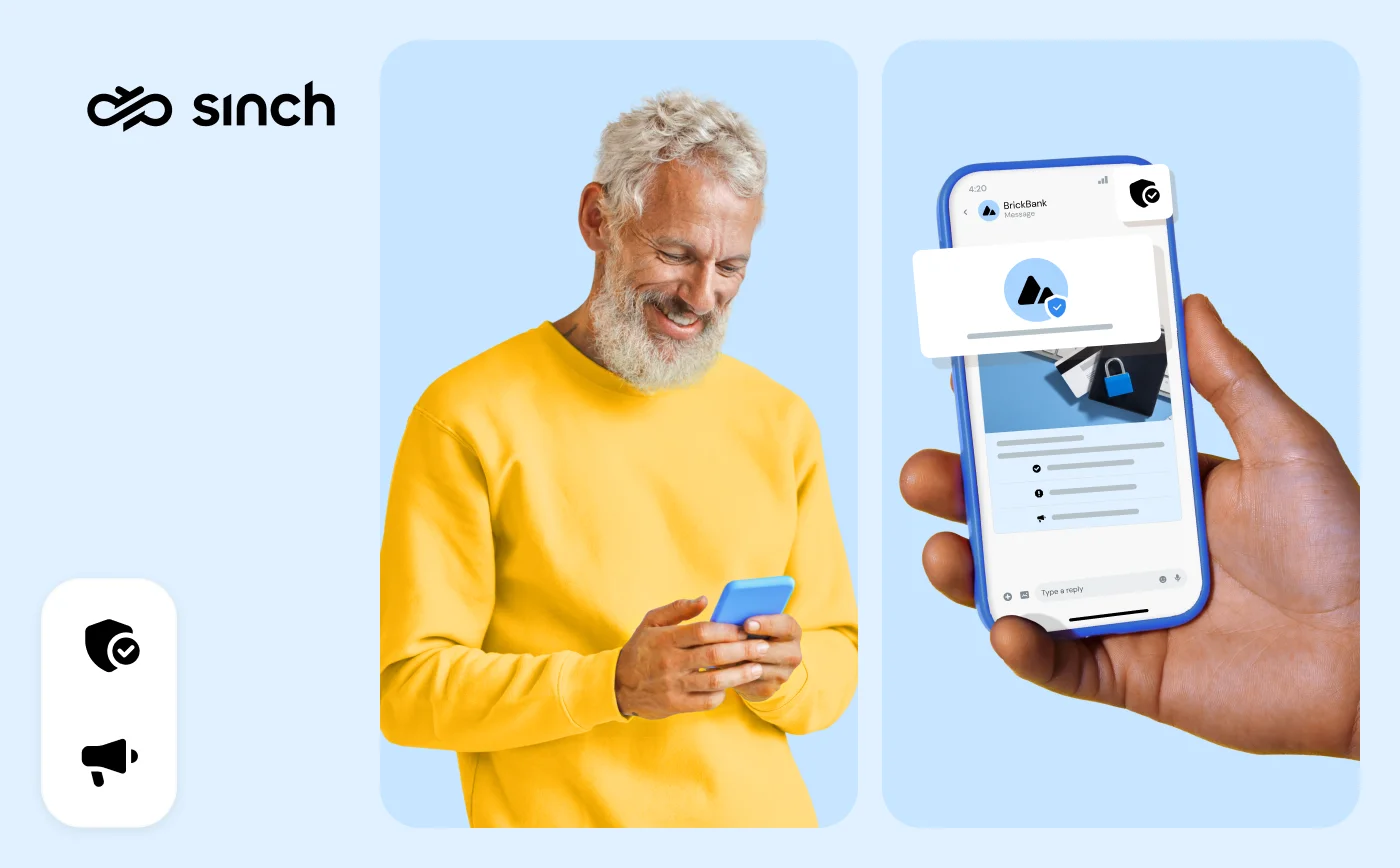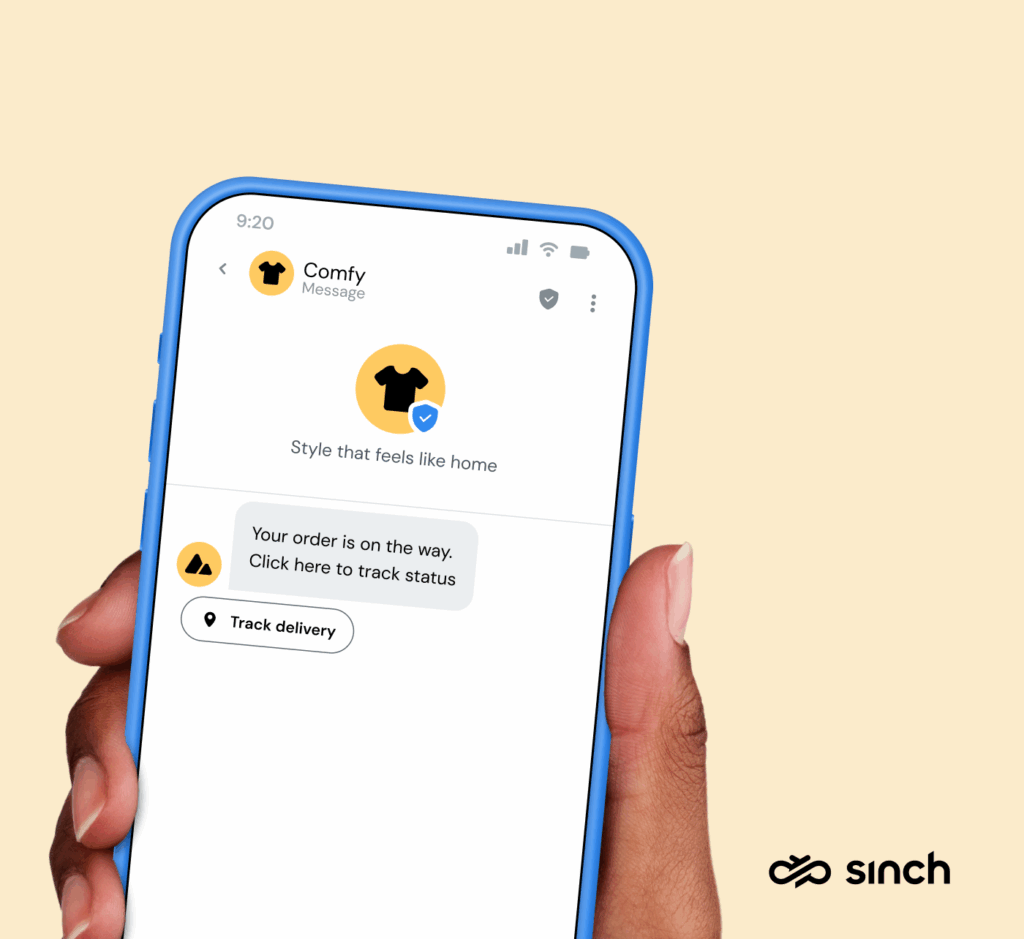Insights
How to build a successful RCS branded messages strategy

Insights

Have you ever wondered how your messages to customers could feel like more than just words on their screens? These could be interactive messages that show videos or maps, or even carousels that let customers swipe through images – all sent from a branded, verified company profile. That’s exactly what Rich Communication Services (RCS) messaging offers, and it’s changing the way customers interact with brands.
As RCS gains traction, especially with Apple supporting RCS for person-to-person (P2P) and application-to-person (A2P) messaging, brands are jumping on board. In fact, our 2025 research shows that 59% of industry leaders familiar with RCS say it’ll be “game-changing” for customer communications. In this article, we’ll explore how RCS branded messages can help build trust in your brand, and then we’ll offer actionable steps from mobile messaging experts about how to create an effective RCS branded messages strategy that improves ROI, drives traffic, and more!
Let’s start with a few of the ways that branded messages signal trust to customers and can help boost engagement.
Embedded within the RCS for Business protocol, verified senders visually confirm a business’s authorization to use its name and logo as part of the conversation. Becoming a verified sender is crucial to RCS, as it signals a stamp of approval from a specialized entity like Mobile Network Operators (MNOs) and reassures customers that messages are legitimate.
After a business has been verified, recipients will see a series of visual cues like the official brand name and logo, and in some cases, a unique checkmark right at the top of the conversation. This authentication is a powerful signal that they’re talking to a legitimate business. In fact, our research shows that 79% of consumers say visual cues in RCS – like an official logo or checkmark – make them more likely to trust a message.

Think about the last time you got a text from an unknown business number. Did you second guess whether it was real? You’re not alone. Our 2025 research found that more than half of consumers have received a legitimate message from a brand in the last year that they initially found suspicious.
With RCS branded messages, that uncertainty disappears. Your business identity is displayed right inside the messaging interface. That means subscribers can instantly recognize who a message is coming from and become more familiar with your brand. Plus, with carousels, images, and personalized content, your messages stand out and are far harder to ignore.
RCS for Business was built for richer, more engaging experiences. This includes:
By sharing content people actually want to interact with, brands build trust and keep attention. It’s no surprise, then, that 40% of business leaders in our research said they expect RCS to boost customer engagement.
Are you intrigued? Branded messaging is what consumers expect in 2025 – and channels like RCS can help you meet those expectations.
When you’re ready to send RCS messages, setting up a sender agent is surprisingly easy when you have the right provider. Then, when you’re ready to plan your campaign, we’ve developed a step-by-step guide to help you craft successful RCS branded messages that can have a considerable impact on ROI, engagement, and sales.
First things first: You need to clarify your brand’s objectives. What does your brand want to accomplish with RCS? Is it boosting customer engagement, driving sales, or perhaps both? Being specific and ensuring these objectives are measurable sets a clear path for what comes next.
Here are a few strategic RCS objectives that we’ve seen brands have success with:
“Most decisions you make regarding your RCS set up and campaigns heavily depend on your business’ goals and priorities. For example, do you want to maximize engagement and visual appeal, or do you care more about minimizing cost? These are individual decisions for every business, so best practices aren’t necessarily a universal guide.”

You wouldn’t chat with a college student in the same way that you would with a retiree, right? The same principle applies here. Your audience has different priorities and interests, and tailoring your tone makes your messages more likely to land. Segmenting by factors like age, location, or shopping habits can help you connect in a more personal way.
You should also consider where your audience is located. RCS for Business is supported on most Android devices, and Apple is rolling it out progressively in select countries with certain carriers.
If your customers are mostly active on WhatsApp, that channel also offers branded business messaging.
Our advice? Start with a small test group to see how people respond, learn what works, and use those insights to shape your broader strategy.
Your brand’s visual identity is key, but it’s only one step to show people your brand – you need to tell it to them as well. This is where a consistent brand voice, tone, and messaging play a key role.
You’ll want to define a few things as you put together your strategy:
With these elements in place, you can ensure every branded RCS message both shows and tells your brand’s identity and value proposition.
Now that your strategy is set, focus on how your messages will look and feel.
Keep your messages short and to the point. Let people know right away why you’re reaching out, and don’t overload them with long or complex content. A good rule of thumb is to keep your first interaction to two or three simple steps. That way, subscribers are more likely to stay engaged the next time you connect.
RCS is a channel people use every day to chat with friends and family – so meet them in that mindset. A friendly tone, conversational style, and even emojis can make your brand feel more approachable and familiar.
As you send messages, use what you learn to shape the next conversation. This makes interactions feel more relevant and natural to what your audience wants.
“Be conversational. Customers engage more when the tone feels personal and helpful. Always maintain a consistent style and format to establish trust.”

Finally, make sure your message flow feels like a real conversation. Buttons and carousels can guide people, but you should also let subscribers reply in their own words. And above all, keep your communication aligned with your goals.
Read some of Google’s conversational UI and UX best practices.
RCS is perfect for personalized messaging. Tailor messages to what you know about your audience – their name, their product preferences, their location… the world is your oyster!
For instance, you can use personalized images on the first standalone card in an RCS carousel, and show products relevant to the subscribers’ gender, location, or interests. Adding the subscriber’s first name in the introduction also adds a personal touch.
Brands can also use RCS messages for cross-selling and upselling tactics.
Want an example? This is exactly what Picard did to create an engaging holiday strategy.
They used RCS to help their customers imagine their holiday menus, taking into account things like dietary preferences, budget considerations, and even their desire to cook.
Picard’s personalized campaign made every recipient feel like they were getting 1×1 service.
Personalized messages will help your messages resonate with your audience, making them feel valued and increasing their engagement with your messages.
Before setting up your RCS Agents, you’ll need to provide proof that your subscribers will be able to opt in and out of your communications. In this way, opt-in is baked into the process.
If you’re already sending SMS through a provider like Sinch, consent for RCS messages typically suffices, but you’ll still need to vet your provider’s approach to handling, storing, and protecting user data in the target market. Make sure that these practices align with your business’ standards and comply with relevant regulations.
Note: Google requires that when someone opts out of your messages, you honor it. This is not just best practice, but it stops your brand from coming across as spammy!
After you’ve launched your campaign, you’ll need to test and iterate.
Make sure you’re measuring how your campaign measures up against your objectives and benchmarks – this can be through KPIs like conversion rate, click rate, read rate, or increases in engagement.
You can also A/B test RCS against other channels like Rich SMS, SMS, or email to see how your audience responds. RCS provides specific metrics like handset delivery receipts, open rates, and read rates, giving you a much more granular view of campaign engagement.
Now that we’ve explored RCS’s potential, it’s clear that it can be a powerful tool for building trust and boosting engagement. But remember, even with Apple’s move towards adopting RCS, you can’t afford to disregard other channels. And that’s exactly where an omnichannel experience can help your brand shine.
All Over-The-Top (OTT) channels have some sort of branded sender functionality – so our advice is to keep your messaging and imagery consistent across channels to strengthen your brand identity.
“RCS is a fantastic channel for branded messaging, but it’s also important to remember that channels like WhatsApp offer similar capabilities. For a truly omnichannel approach, businesses should consider how they can leverage the unique strengths of each channel to create a cohesive, engaging customer experience.”
Choosing RCS isn’t about replacing other channels – it’s about using it strategically, so your messages have maximum impact.
And when you choose to send RCS messages through a provider like Sinch, you can ensure all messages are delivered based on your audience’s preferred channel, coverage availability, or handset capability.
Building an RCS strategy takes time – it’s not a sprint. Think of it as a journey that you can be a part of wherever your business is today. Let’s look at it in three phases: Walk, Run, and Fly.
Did you know you can upgrade your SMS campaigns to RCS with little to no overhead? Pick one or two high-impact SMS campaigns and upgrade them to RCS. This gives you space to test, measure results, and learn before scaling.
The best part? Your existing text messages still work. If a customer has RCS enabled, they’ll see a branded, secure RCS message. If not, it automatically falls back to SMS.
Over time, you can start layering in rich features. Suggested actions, carousels, images, and videos all help turn standard campaigns into interactive experiences. This is where your messages shift from simple updates to dynamic, two-way conversations.
The final step is to go beyond one-off interactions. With AI support and conversational design, RCS can feel like a natural back-and-forth, guiding customers with helpful cues and personalized suggestions.
Ready to get started? Download the full RCS guide to learn how to advocate for RCS in your organization and put these steps into practice.
Or, if you’re looking for other inspiring RCS content, check out our RCS messaging resource hub for valuable insights on crafting rich messaging experiences that your customers will love.